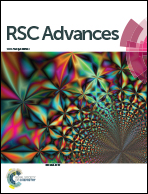Designing coexisting multi-phases in PZT multilayer thin films: an effective way to induce large electrocaloric effect
Abstract
Coexisting multi-phases in PbZrxTi1−xO3 multilayer thin films were successfully fabricated using the sol–gel method. The microstructure and electrical of the multilayer films with different growth sequences, including the up multilayer films and down multilayer films, have been systematically investigated. The results indicate that a large electrocaloric effect (ECE) is obtained at the temperatures much below the Curie temperature. At room temperature (25 °C), the change in temperature (ΔT) values of the up multilayer and down multilayer thin films are 20.2 K with the applied electric field E = 826 kV cm−1 and 46.3 K with the E = 992 kV cm−1, respectively. In addition, both the films exhibit outstanding ECE of around 145 °C, and ΔT values of 28.9 K and 14.8 K have been obtained for the up multilayer and down multilayer thin films. The results indicate that the antiferroelectric/ferroelectric (AFE/FE), ferroelectric/ferroelectric (FE/FE) phase transition and the synergistic effect of the AFE/FE and FE/FE phase transition are as effective as the FE/PE phase transition. In particular, the multilayer thin films are endowed with refrigeration ability at multi-temperature zones due to the coexistence of multi-phases.



 Please wait while we load your content...
Please wait while we load your content...